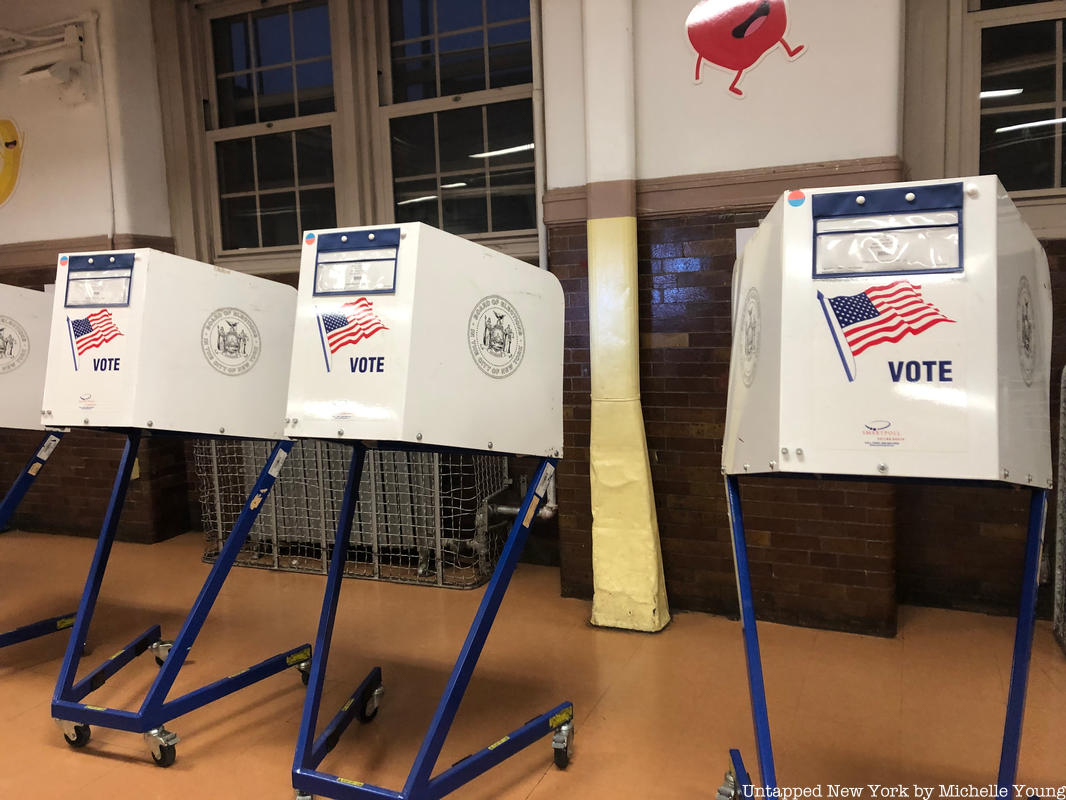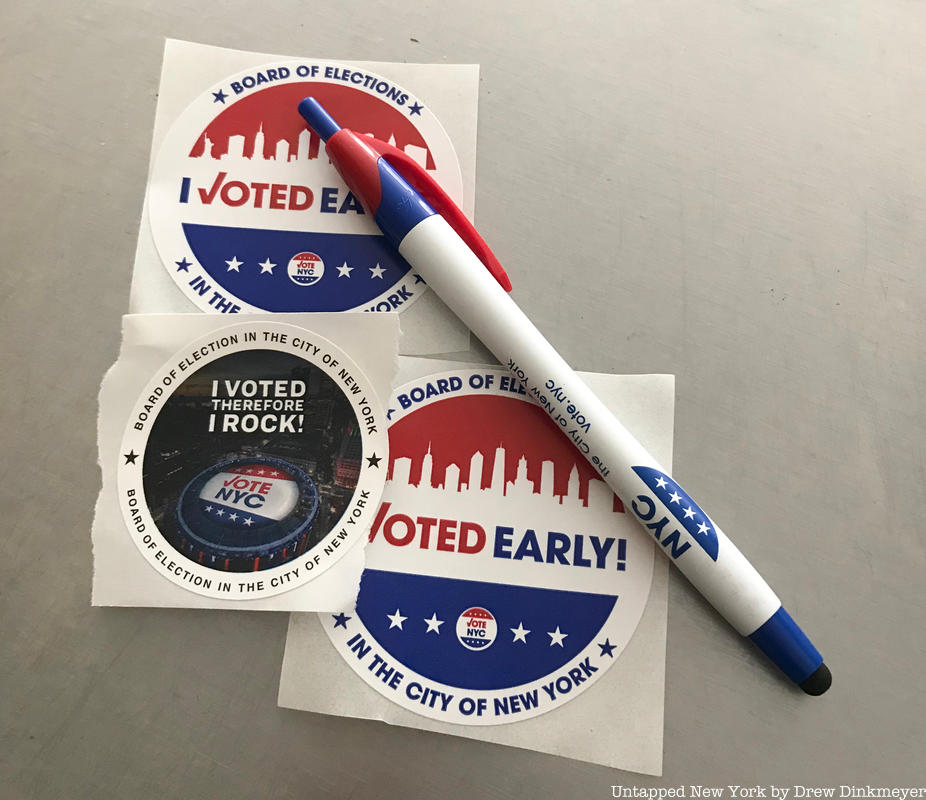Election season 2020 is here and never has the simple act of doing the bare minimum to participate in democracy seemed more important. With our voter guide for the 2020 election, we’ll help you figure out where to vote and what’s on the ballet. First, find your voting location and see a sample ballot here. Big picture context: In New York State, registered Democrats outnumber Republicans 2-1. Many offices were essentially decided in the June primary, when in many districts at all levels of office, two or more Democrats ran against each other to determine who would be the candidate in the general. But there are still some contentious elections you can impact besides the U.S. Presidency, and voting never seems to go smoothly in New York. The June primary was no exception, with ballot disputes, lawsuits, and other confusions!
How to cast your vote?
Absentee / by mail: You must postmark, apply online, email or fax completed application for the General Absentee ballot by October 27. (Instructions here.) You can also apply in-person by November 2, although at point you might as well just vote in-person!
You can drop off your absentee ballot in one of the following ways: 1. At an early polling site without waiting in line (look for the red, white and blue drop boxes with the Statue of Liberty on it) 2. At a poll site on election day (November 3rd) by 9 PM 3. At your County Board of Elections (your location here). 4. Or gdo to your local post office and make sure it has a postmark on it by November 3rd (mail ballots were the source of the lawsuit in the June primary, so follow the instructions on your ballot and get the postmark).
In-person early birds: As of 2019, it’s become even easier with the passage of early voting legislation in New York. You can vote early from Saturday, October 24 to Saturday, November 1. Early voting hours differ by location. Please check where your early voting poll site is and that it is open before you go. Your early polling site is most likely not the same as your normal poling site.
Election day voting: Polls in New York are open from 6am – 9pm on Tuesday, November 3. Double-check your poll site before you go!
Attire / mood: Poll sites in New York require a mask / face covering and will abide by social distancing guidelines. Your poll workers are putting themselves at risk for COVID-19 by facilitating the functionality of democracy; be kind to them!
What’s on your ballot!?
Elections this year are for offices at the federal, state, and county level. Here are some key races:
US PRESIDENT
You might have heard about this? Two white guys in their 70s are running! The news is overrun with this coverage, so we assume you’re good.
US CONGRESS
All US Congressmembers are up for reelection this year.
New York has 27 congressional districts. Democrats hold 21 of them after flipping three seats in 2018. (Here’s a helpful map.) A fun fact (!!): 2020 will be the final election with the current district lines. Redistricting will occur in 2021 based on data from the 2020 Census. In most New York City districts, the Democratic candidate is all but a shoo-in. (Still, go VOTE!)
The only contested race in NYC is in District 11 (Brooklyn / Staten Island), where freshman Rep. Max Rose (D) will face NYS Assemblymember Nicole Malliotakis (R). This is a helpful synopsis of their feud for the seat and where they stand on the issues.
In Long Island, (very) longtime incumbent Rep. Peter King (R) will not be running for reelection. This open seat is a race between Jackie Gordon (D), a Jamaican immigrant and military veteran who served for 12 years on the Babylon Town Council and State Assemblyman Andrew Garbarino (R). This election is significant because of the HIGH STAKES! (Apparently it’s a test of Republican power on Long Island.) In Suffolk County, incumbent Lee Zeldin (R) is running against Nancy Goroff (D), who defeated Perry Gershon and two other challengers in the June Democratic primary. Zeldin narrowly lost to Gershon in 2018.
NEW YORK STATE SENATE
Most of the action happened in the primary, where there was a mini sweep by DSA-backed candidates and other insurgents against incumbents of varying stripes. In almost every NYS Senate District in New York City, voters are overwhelmingly Democrats, so not a lot of nail-biting is expected. (Still, go vote!) Bigger picture: Democrats in the NYS Senate are close to getting a supermajority, which is a big deal.
One New York City race to watch is in State Senate District 22 (Brooklyn – Bay Ridge, Dyker Heights, Gravesend, Manhattan Beach and Marine Park), where freshman Andrew Gounardes (D) is running against challenger Vito Bruno (R), a club owner and music promoter. In 2018, Gounardes won the district by a tight margin (1,129 votes!) against longtime incumbent Marty Golden, who had held the seat since 2003. This is a contested district, and being South Brooklyn (AAAAYYYY!), people have very strong and directly contradicting opinions (Match-up in this round is Guardian Angels founder Curtis Silwa vs. Local Democratic District Leaders) about the candidates.
NEW YORK STATE ASSEMBLY
Likewise in the NYS Assembly, most of the action happened in the primary. (Still, go vote!). There is one contested NYC race for an open seat in the 64th Assembly District (Staten Island and Bay Ridge, Brooklyn), which NY1 has dramatically dubbed a “Barometer for the Nation.” The seat was given up by current Assemblymember Nicole Malliotakis for her run in the 11th US Congressional District (see above).
Here, in the running are Michael Tannousis (R), a former prosecutor and aide to Staten Island Borough President Jimmy Oddo and Brandon Patterson (D), who worked for State Senator (and IDC member! Diane Savino on Staten Island. Tannousis has the endorsement of the PBA; Patterson is endorsed by major labor unions, including UAW (prestigious!) and the Transit Workers Local. The district has been represented by a Republican for the last ten years, even though registered Democrats outnumber Republicans here. DUN-DUN-DUN.
DISTRICT LEADER
District Leader is an unpaid volunteer who helps mobilize voters and address issues related to civic engagement. There is at least 1 District Leader (DL) per NYS Assembly District. The DL represents party members in their district. These elections are every 2 years. The District Leader is decided in the primary, but the candidate will appear on your ballot in the general election.
COUNTY SEATS
New York State Judiciary
Judges judges judges! There are a lot of judges! Most of them are democrats. There are judicial elections every year, although not in every district. Every person in New York lives in multiple judicial districts, each with their own election cycle. Yes, that means it is confusing and you have to pay attention.
Often for the judiciary, the election is to fill multiple seats. Your ballot may say “Choose up to 3.” That means you can choose up to three candidates, one per seat. The judiciary is extremely important. As the third branch of government, it can be an important check on the executive and legislative branches.
Judges are in charge of sentencing people who have been convicted of crimes; the person making those decisions (e.g., sentencing someone to 5 years in prison vs. 12 months of drug rehabilitation) can make a big difference in long-term justice outcomes. Judges have the power to make a lot of important decision every single day. It matters who they are and what they believe.
If you live in a district where it feels like every decision is made for you, along party lines, voting for judges that align with your beliefs can reinvigorate your belief in the power of democracy, and provide the priceless opportunity to put your money (or, erm, your vote) where your mouth is. It helps to look up your ballot before you go vote, and see who’s on there and what kinds of decisions they make. Google the judges who represent you. You might have gotten some interesting things in the mail from them.To learn more about the judges running in NYC, read this; it’s helpful.
County Committee
Each election district (ED) is made up of a few city blocks. Each ED has 2 to 4 seats in the general membership of the county committee. County committee members are volunteers who are the lowest levels of county government, but they play an important role: helping choose local judicial candidates, picking the party nominee in special elections, and organizing local neighborhoods.
Many county committee seats go unfilled (you should run!), and in contested races, the candidates are decided in the primary, but the candidates will appear on your ballot in the general election.
So with all that, remember you can still register to vote absentee, or start voting early Saturday, October 24th. Check where your early voting poll site is and that it is open before you go! And wear your masks.







